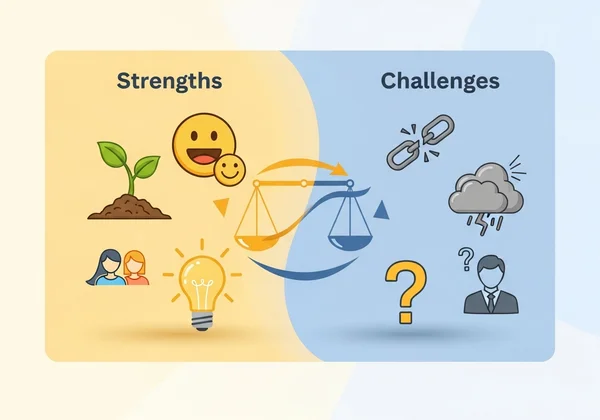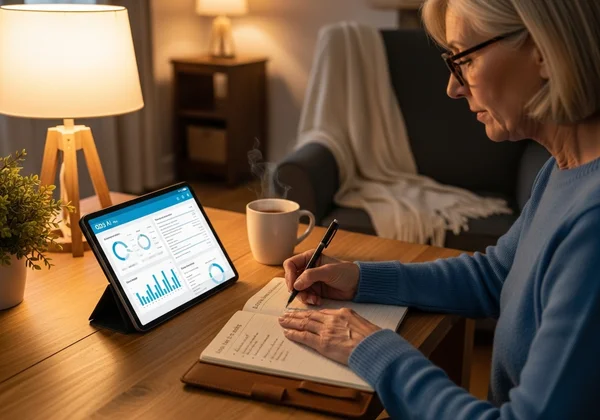Your Geriatric Depression Scale (GDS) AI Report: Personalized Insights & Mental Health Plan
Received your AI-powered Geriatric Depression Scale (GDS) report? Great! This isn't just a score; it's a personalized roadmap designed to help you understand and nurture your emotional well-being. While your GDS score offers a quick snapshot, this AI analysis delves deeper, transforming raw data into practical insights. What makes these findings unique? They translate your answers into actionable insights, helping you, your family, or your healthcare provider understand the subtle patterns behind your feelings. This guide will walk you through interpreting your personalized findings and turning them into a concrete plan for a healthier, more fulfilling life. If you haven't yet experienced this unique feature, you can take the GDS test today.

Understanding Your GDS AI Report: Beyond the Score
The primary purpose of the GDS AI report is to add depth and context to your screening results. A traditional score tells you what your potential level of depressive symptoms might be, but the AI analysis delves into the why and how. It examines the relationships between your responses to uncover underlying themes that a simple tally cannot reveal. Think of it as the difference between seeing a single frame and watching the entire movie of your emotional state over the past week.
What Makes This Analysis Unique?
The true innovation lies in its ability to process nuances. Instead of just counting "yes" or "no" answers, our AI algorithm is designed to identify patterns. For example, it can highlight a contrast between positive social engagement and feelings of personal dissatisfaction, providing a much richer picture of your mental landscape. This AI depression analysis provides a tailored perspective that moves beyond generic advice and offers suggestions rooted in your specific responses.
Navigating the Key Sections of Your Personalized GDS Report
Your report is structured to be intuitive and easy to follow. You will typically find several key sections designed to guide you from raw data to actionable understanding. These often include an overall summary, a breakdown of identified strengths and challenges, and a list of personalized suggestions. Familiarizing yourself with this layout is the first step toward leveraging the full power of your results, which you can generate after completing the free GDS screening.
Decoding Personalized Insights: Strengths, Challenges, and Trends
This is where your report truly comes to life. The AI doesn’t just point out problems; it provides a balanced view of your emotional well-being. Understanding how to interpret these insights is key to making meaningful progress. This process is a core part of interpreting GDS insights effectively for personal growth and informed discussions.

Identifying Your Mental Well-being Strengths
Your report will prominently feature areas where you show emotional resilience and positivity. These are your strengths. Perhaps you indicated a strong sense of satisfaction with your life or a healthy level of social activity. The AI highlights these because they are the foundation you can build upon. Recognizing and celebrating these strengths is a powerful, evidence-based approach to improving overall mental health. They are your personal assets in the journey toward well-being.
Pinpointing Potential Challenges and Areas for Growth
The report will also identify response patterns that may suggest emotional hurdles. It might flag feelings of emptiness, a lack of energy, or a tendency to worry about the past. It's crucial to view these not as failures but as "areas for growth." The AI presents this information neutrally, without judgment, simply as data points that warrant attention. Knowing where the challenges lie allows you to direct your energy and conversations with healthcare providers more effectively. If you're a caregiver, this section can help you understand what support your loved one might need.
The AI's Role in Highlighting Emotional Patterns
How does the AI accomplish this? By analyzing your complete set of answers, it can detect subtle but significant emotional patterns. For instance, you might answer "no" to feeling helpless but "yes" to feeling that your situation is hopeless. A simple score might balance these out, but the AI recognizes this specific combination as a potential indicator of passive despair, a critical insight for a healthcare professional. It connects the dots between individual answers to reveal a more coherent story about your emotional state.
From Analysis to Action: Crafting Your Personalized Mental Health Plan
The true value of this report comes from turning its insights into actionable steps. This section is dedicated to helping you use your personalized mental health plan as a springboard for positive change. The goal is to transform the AI's data-driven suggestions into real-world habits and informed conversations.
Translating AI Suggestions into Practical Steps
Your report will offer several suggestions based on its analysis. These are starting points, not prescriptions. For example, if the report suggests "increasing social engagement," you can translate that into concrete, manageable actions. This could mean scheduling a weekly phone call with a family member, joining a local book club, or even trying a class at a community center. The key is to break down the suggestion into small, practical steps that feel achievable to you.

Preparing for Discussion with Your Healthcare Professional
This is the most critical step. Your GDS AI Report is a powerful tool to facilitate a more productive and detailed conversation with your doctor, therapist, or counselor. Before your appointment, review the report and highlight the strengths and challenges that resonate most with you. You can bring a printout or have it ready on a device. This allows you to move beyond "I've been feeling down" to "My report highlighted feelings of hopelessness despite good social connections, can we talk about that?" This level of detail helps professionals provide you with the best possible care. Remember, this is a screening tool, and only a qualified healthcare professional can provide a diagnosis.

Setting Realistic Goals for Emotional Well-being
Using the insights from your report, you can set small, realistic goals. If a challenge area is low energy, a goal might not be to run a marathon but to take a 10-minute walk three times a week. The report gives you the "what" (the challenge), and you work with your support system to define the "how" (the goal). This proactive approach, guided by your personalized data, is a cornerstone of modern mental health management. To begin this journey, you can try the online tool.
Your Journey Forward: Taking Action with Your GDS AI Report
Ultimately, your GDS AI Report empowers you. It offers a clear, data-driven look into your emotional landscape, showcasing your strengths and identifying areas where you might need extra support. By exploring its insights and creating a plan, you're taking a significant, proactive step toward nurturing your mental health.
Use this report as a catalyst for conversation, a guide for self-reflection, and a bridge to professional support. Your emotional health is a vital part of your overall quality of life. Start exploring what your results mean and discover your results on our secure platform today.
Frequently Asked Questions About Your GDS AI Report
How accurate is the AI-Powered GDS Report?
The report's foundation is the scientifically validated Geriatric Depression Scale. The AI layer adds a powerful analytical lens to interpret the patterns in your answers, providing insights that go beyond the scope of a simple score. While it is a highly sophisticated guide, it should be viewed as a supportive screening tool, not an infallible measure. Its primary purpose is to enhance your understanding and facilitate a conversation with a qualified professional.
Is the GDS AI Report a diagnostic tool for depression?
No, absolutely not. This is a critical point to understand. The GDS AI report is a screening tool designed to identify potential symptoms and patterns that may warrant further attention. It is not a substitute for a comprehensive evaluation by a doctor, psychiatrist, or psychologist. A formal diagnosis can only be made by a licensed healthcare professional after a clinical assessment. We encourage you to get your GDS score and discuss the report with your provider.
What should I do if my AI report suggests significant challenges?
If your report indicates a high score or highlights significant emotional challenges, the most important step is to not panic. See the report as a helpful indicator that it's time to seek professional guidance. Schedule an appointment with your family doctor or a mental health specialist to discuss the findings. This report gives you a valuable, structured starting point for that crucial conversation.
Can I share my GDS AI Report with my family or caregiver?
Yes, sharing your report can be an excellent way to help your loved ones understand what you're experiencing and how they can best support you. The clear, structured format of the report can make it easier to talk about sensitive feelings. It can also be an invaluable tool for caregivers seeking to provide more informed and empathetic care. You can easily share your results after completing the geriatric depression scale.